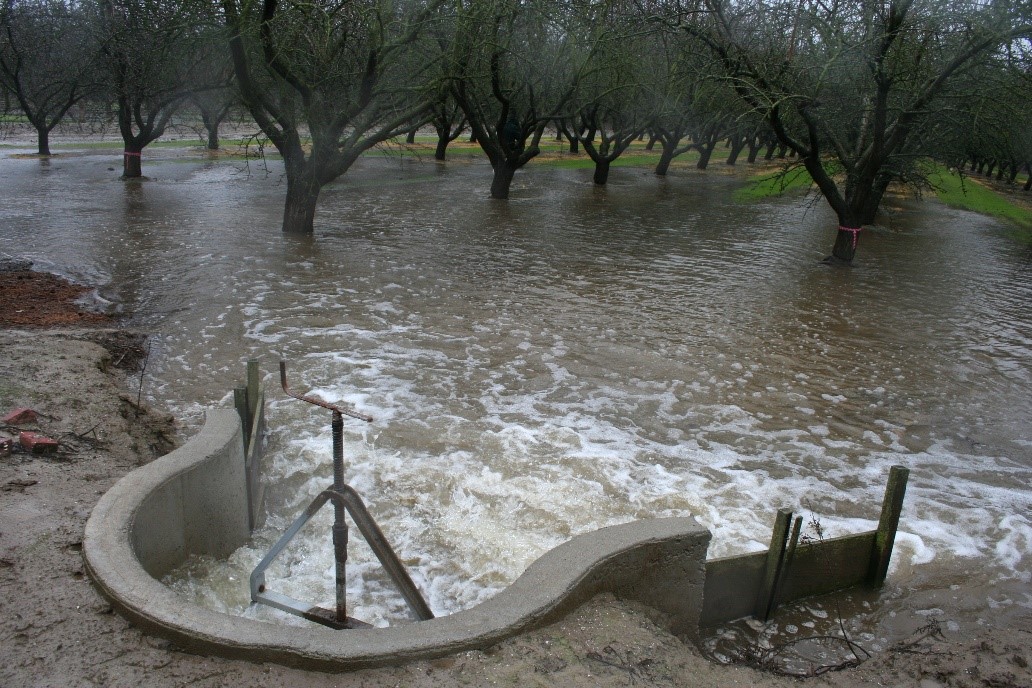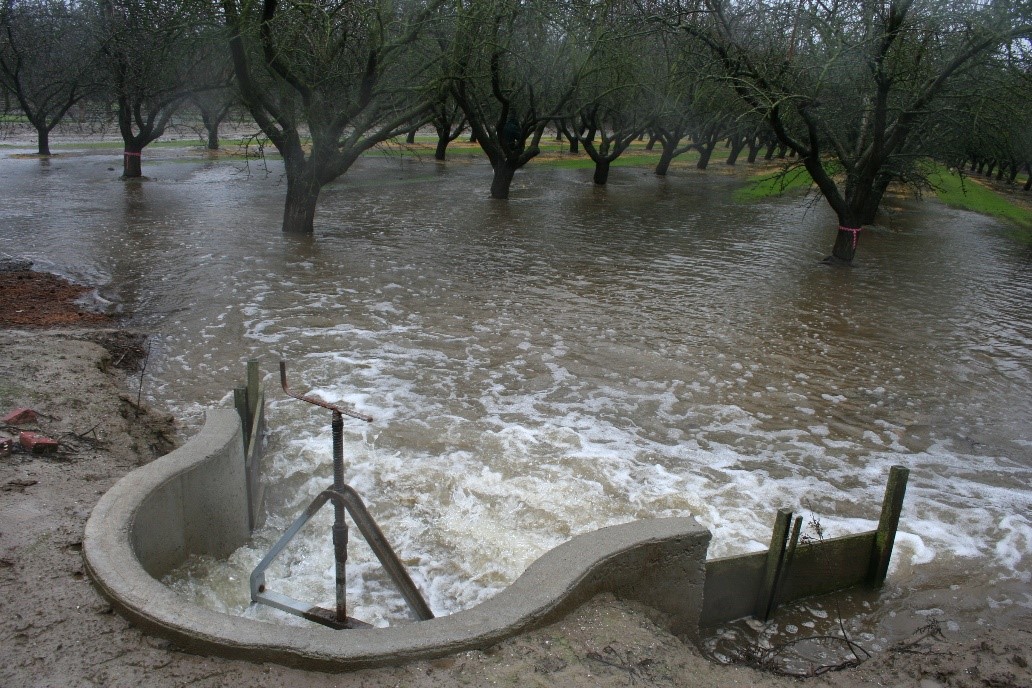Multiyear UC Davis study shows little impact from winter flooding, with best outcomes in sandy soils
Groundwater contributes around 30% of the water in California in a non-drought year and some 60% in dry years. Ensuring groundwater supplies are maintained is critical to the long-term health of the state. In some areas of the Central Valley, with both regulatory- and weather-driven losses of surface water, groundwater has been overdrafted. The Sustainable Groundwater Management Act (SGMA) passed in 2015 is requiring that groundwater be managed in a sustainable manner in the long run.
The question now is how to do that and where almonds may be able to play a role.

Groundwater recharge is the idea of purposely flooding when there is excess available water to allow the water to percolate down into the aquifer. For the Central Valley, high winter rainfalls and snow melts are key opportunities. In addition, fall releases from dams to create space for winter rains and possible flooding can be an opportunity where excess water is available.
Flooding almond orchards during the dormant season could help accelerate natural groundwater recharging of aquifers. While growers have long been wary of overwatering during the growing season, recent research has investigated the effects of winter flooding and preliminary results are showing promise.
“With careful attention to soil suitability and with appropriate access to water and infrastructure,” said Gabriele Ludwig, director for Sustainability and Environmental Affairs, Almond Board of California (ABC), “almond growers have an opportunity to play a role in groundwater recharge.”
Encouraging results: on-farm experiment
Results from an Almond Board-funded multiyear study at the University of California, Davis, “Flooding Orchards to Replenish Groundwater,” appear to support the practice of winter recharging, particularly for orchards with sandy soils.1
The on-farm experiment — conducted in Delhi, Modesto and Orland orchards — is now complete for the winter-recharging portion of the study. The researchers applied an extra 24 inches of water in December and January 2015–16 and 2016–17, in addition to precipitation.
The experiment compared impacts on three almond orchards with different soil infiltration ratings, based on the Soil Agricultural Groundwater Banking Index (SAGBI). Soils at these three sites were ranked as excellent, good or moderately good for infiltration, allowing researchers to compare groundwater retention and saturation effects on different soils.
Flooding impact measured, stem to root
Plant physiology studies measured stem-water potential as an indicator of tree hydration. For a worm’s eye view of how flooding affected root growth during dormancy, researchers used underground cameras specially made for the task. They also measured yield before and after recharge.
Over the two-year study, researchers found few significant differences between trees in the control group and those in the flood treatment group. The Delhi-site trees, growing in sandy soil, remained more hydrated during the growing season. And their roots showed a 30–70% longer lifespan than the control group — possibly because flooding flushed harmful salts and nitrates from the root zone.
The Modesto site, which is flood irrigated throughout the growing season, appeared unaffected. “It looked like the additional recharge in the winter had no negative effect at all,” said Dr. Helen Dahlke, associate professor of Integrated Hydrologic Sciences in the Department of Land, Air and Water Resources at UC Davis. The trees seemed to be pretty well adapted to these types of conditions in general.”
The Orland site’s soil is moderately good for infiltration and with all the winter rain in 2016–17 the researchers struggled to apply any additional water. However, even in these soils there was deep percolation of water.
The research has also been looking at how nitrates and salts move with the applied winter water. Growers, especially in sandier soils, will need to be mindful of their nitrogen management to minimize the buildup of nitrates leaching into the groundwater along with the water.
Groundwater recharge holds great potential as a tool that can help growers adapt to a drier future — but not all farms are good candidates. Determining whether your orchard could benefit depends on your soil including permeability deeper down in the soil profile, your local water district and water use regulations. Winter flooding in sandier soils, so far, is not showing any concerning impacts on the almond trees but will require careful nitrogen management.
Could your orchard benefit?
Precise mapping of water penetration within an orchard could provide guidance for more targeted recharge, as well. The Land IQ almond mapping analysis, developed by ABC in partnership with Land IQ, shows that nearly 675,000 acres of almond orchards could benefit from groundwater recharge, based on soil permeability. To see an orchard-by-orchard analysis, visit Almonds.com/Maps.
Farmers planning to convert to microsprinkler or drip systems should consider maintaining their flood irrigations systems for potential recharge use. With groundwater use now regulated by SGMA, recharging practices may also help farmers receive credits for their efforts with local groundwater districts.
To learn more about current and new water management practices, visit Almonds.com/Irrigation.
Watch Dr. Helen Dahlke discuss her groundwater recharge research in a video interview here.
[1] UC Water News - Farms serve as natural experiment site for large-scale groundwater recharge. (2018, January 18). Retrieved February 20, 2018, from http://ucwater.org/news/onfarm-groundwater-recharge


